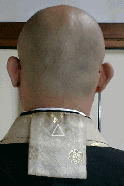Hi folks,
I was just wondering what the tree inspired the broken pine needle on the back of our rakusu's looks like? Does anyone know what they are call?
Thanks!
Gassho
Sattoday
Hoseki
I was just wondering what the tree inspired the broken pine needle on the back of our rakusu's looks like? Does anyone know what they are call?
Thanks!
Gassho
Sattoday
Hoseki










Comment